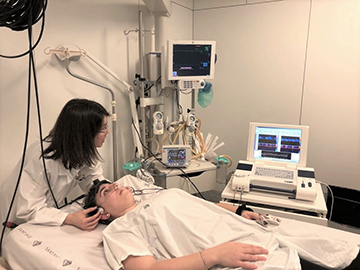
Using forehead sensors to emit and detect laser light, a new optical system monitors blood flow after stroke.[Image: Raquel Delgado-Mederos / Hospital de la Santa Creu i Sant Pau, Spain]
A team of clinicians and researchers from Barcelona, Spain, has demonstrated a new optical device for real-time, continuous monitoring of blood flow and oxygen saturation in five patients with acute ischemic stroke (AIS). The optical monitoring system combines diffuse correlation spectroscopy (DCS) and near-infrared diffuse optical spectroscopy (NIRS) sensors into a portable, easy-to-use device (Biomed. Opt. Express, doi: 10.1364/BOE.9.001262). By placing the device’s two probes onto a patient’s forehead, physicians were able to monitor and confirm the effectiveness of drugs used to dissolve AIS-causing blood clots.
Team members say findings from their small-scale demonstration support further studies of the device with larger patient samples. Non-invasive instruments, like the one proposed by this research team, could give healthcare providers quick and continuous information on ischemic stroke treatment effectiveness, thereby improving clinical outcomes.
Real-time, continuous monitoring
An ischemic stroke occurs when a clot cuts off blood flow to an area of the brain. Removing or dissolving the clot and restoring blood flow to the brain as soon as possible after an ischemic stroke is essential for preventing permanent damage.
There are two common methods for measuring blood flow to the brain in people being treated for AIS. Magnetic resonance or computed tomography can be used to take flow measurements at single time points, and transcranial Doppler ultrasonography can be used to continuously monitor blood flow, but only in large vessels. The researchers say their new DCS-NIRS device bests the current standard-of-care because it can provide continuous, real-time data on cerebral blood flow and on oxygenation in large and small blood vessels.
While DCS-NIRS diffuse optical assessment of blood flow and blood oxygenation isn’t new, the Barcelona team aims to take DCS-NIRS from its current home in the research laboratory to the patient’s bedside by making a device that is portable and easy to use.
The system consists of two probes, a DCS probe and an NIRS probe. The DCS probe measures blood flow by collecting data from speckles produced by 785-nm laser light as it moves through the patient’s tissue and blood vessels. The NIRS probe uses wavelength-dependent light attenuation (from two continuous-wave lasers at 690 nm and 830 nm) to measure blood oxygenation.
Bedside demo
The researchers conducted a proof-of-concept study with five patients admitted to the emergency department with AIS. The two probes were placed opposite each other on the forehead. Data collection began soon after the patients were given plasminogen activator (rtPA) to dissolve blood clots and restore blood flow to the brain. Data from the five-person study showed an increase in brain blood flow and blood oxygenation during the first 2.5 hours after treatment with rtPA. After 24 hours, four of the five patients had complete restoration of normal blood flow to the brain.
Although the DCS-NIRS device is still in the early stages of development, the researchers say results from this study are promising and that the device could someday contribute to a better understanding of treatment and recovery in people with AIS.
Research team leader Raquel Delgado-Maderos, Hospital de la Santa Creu i Sant Pau, Spain, said in a press release, “The potential impact of this new approach is quite significant since stroke is the leading cause of long-term disability in adults worldwide.”
